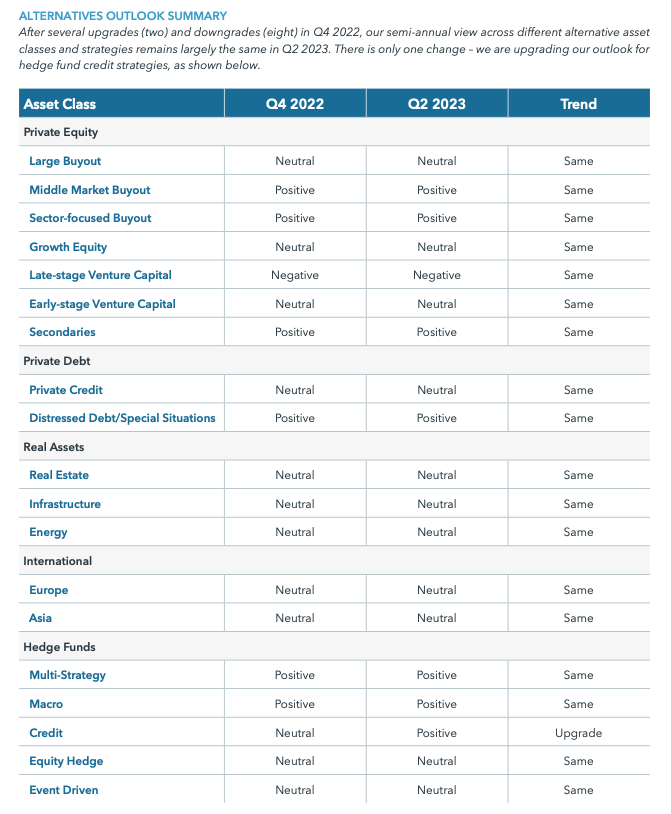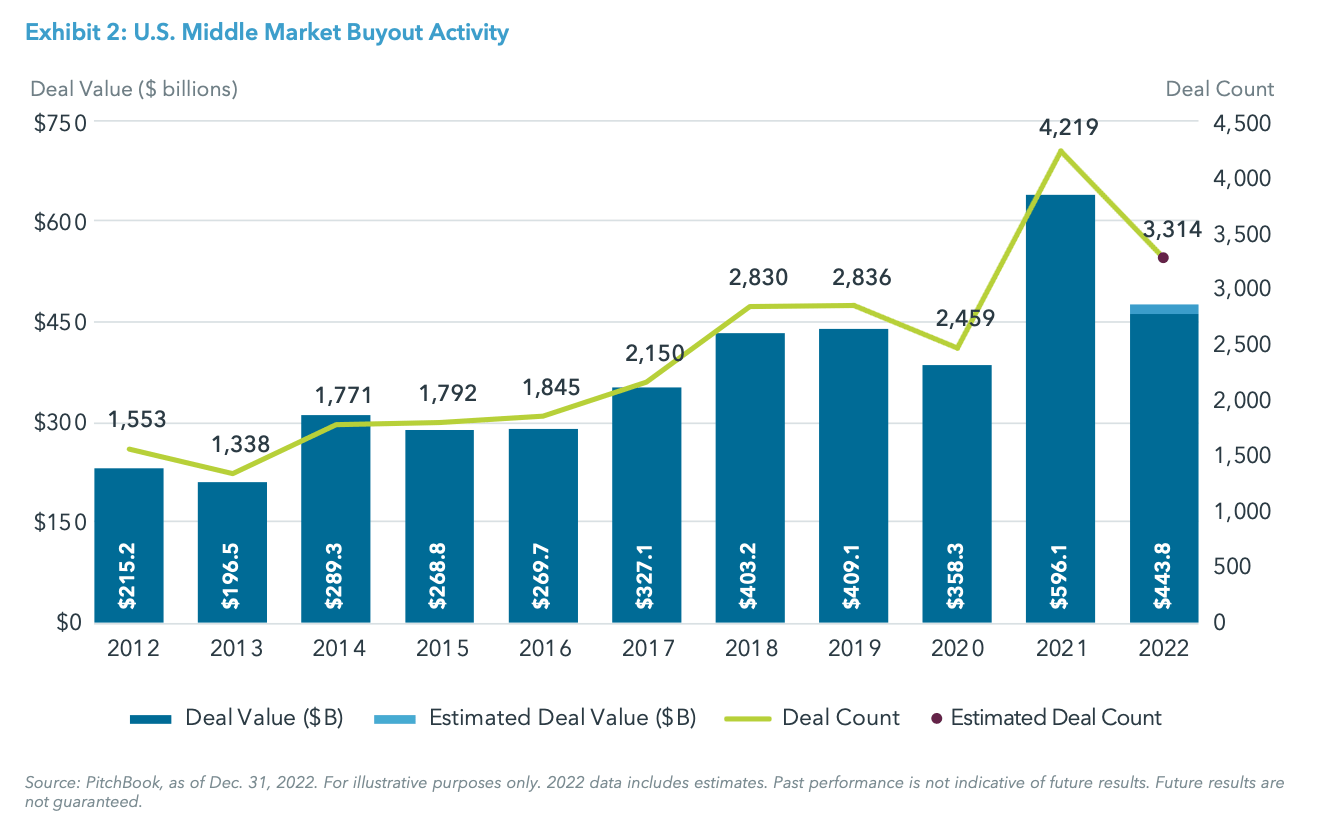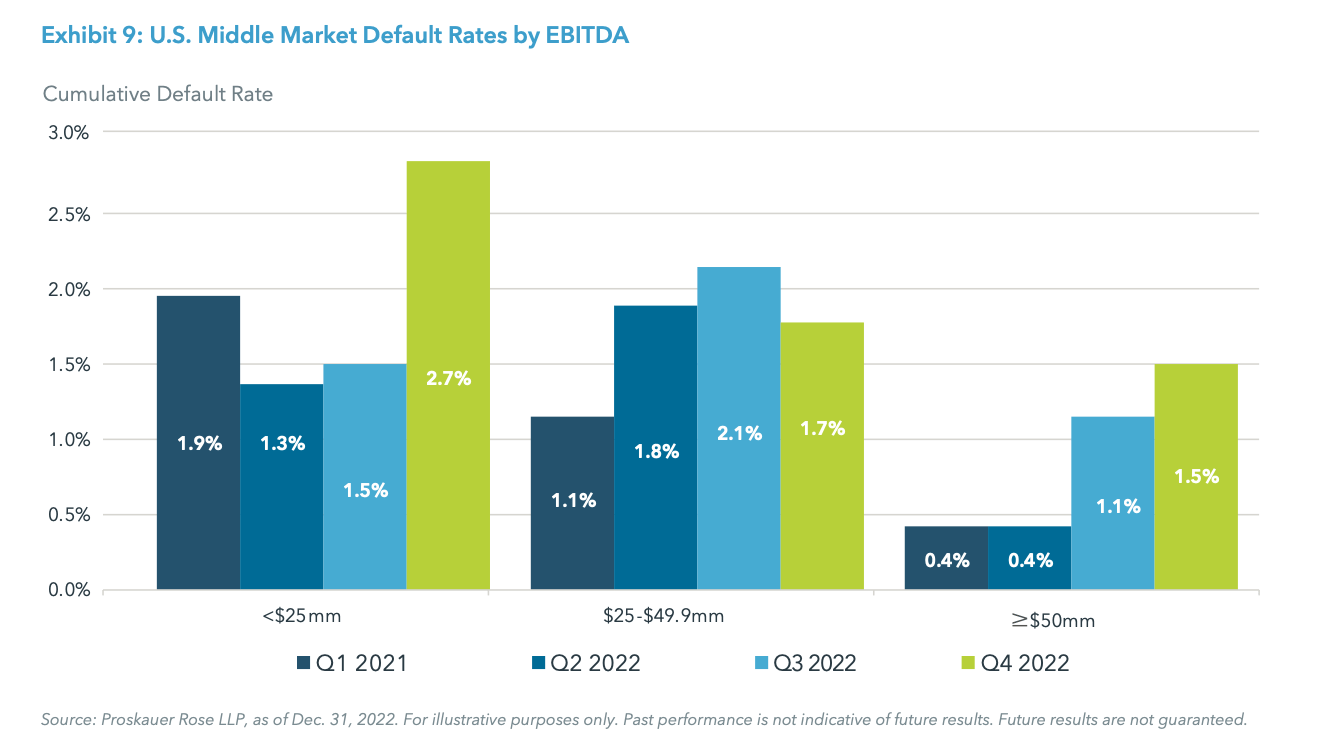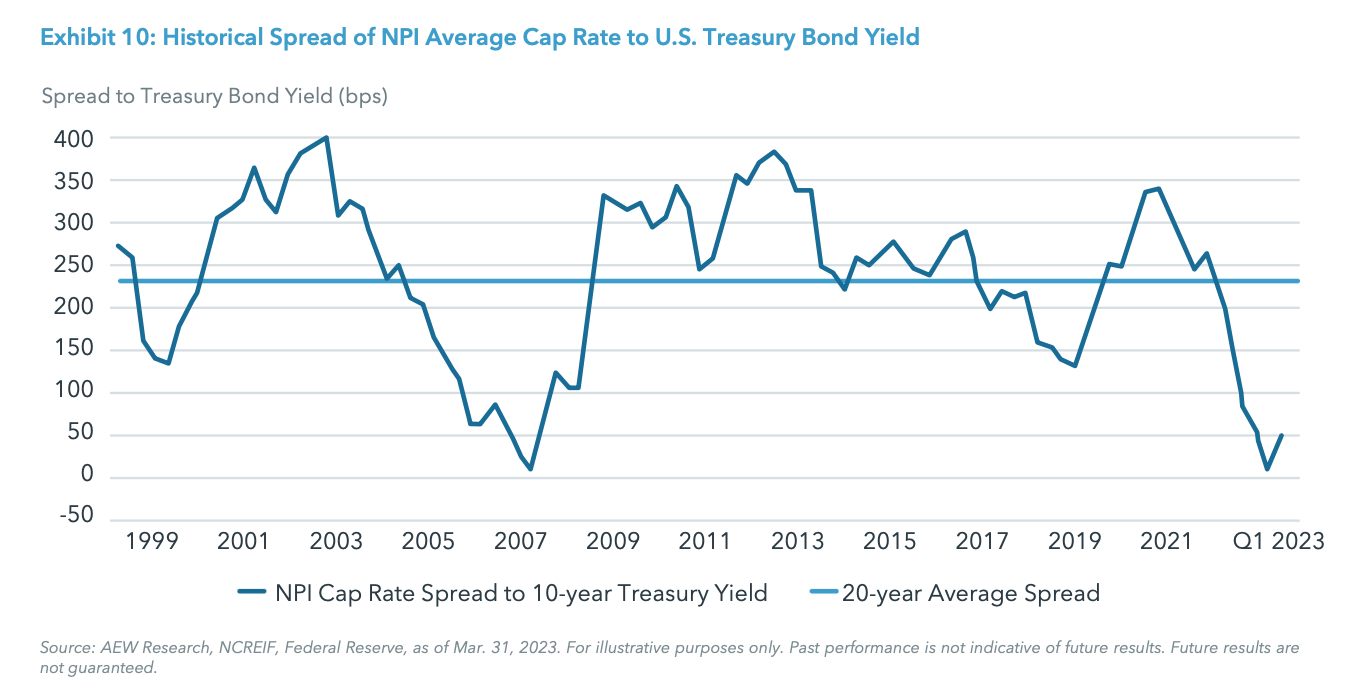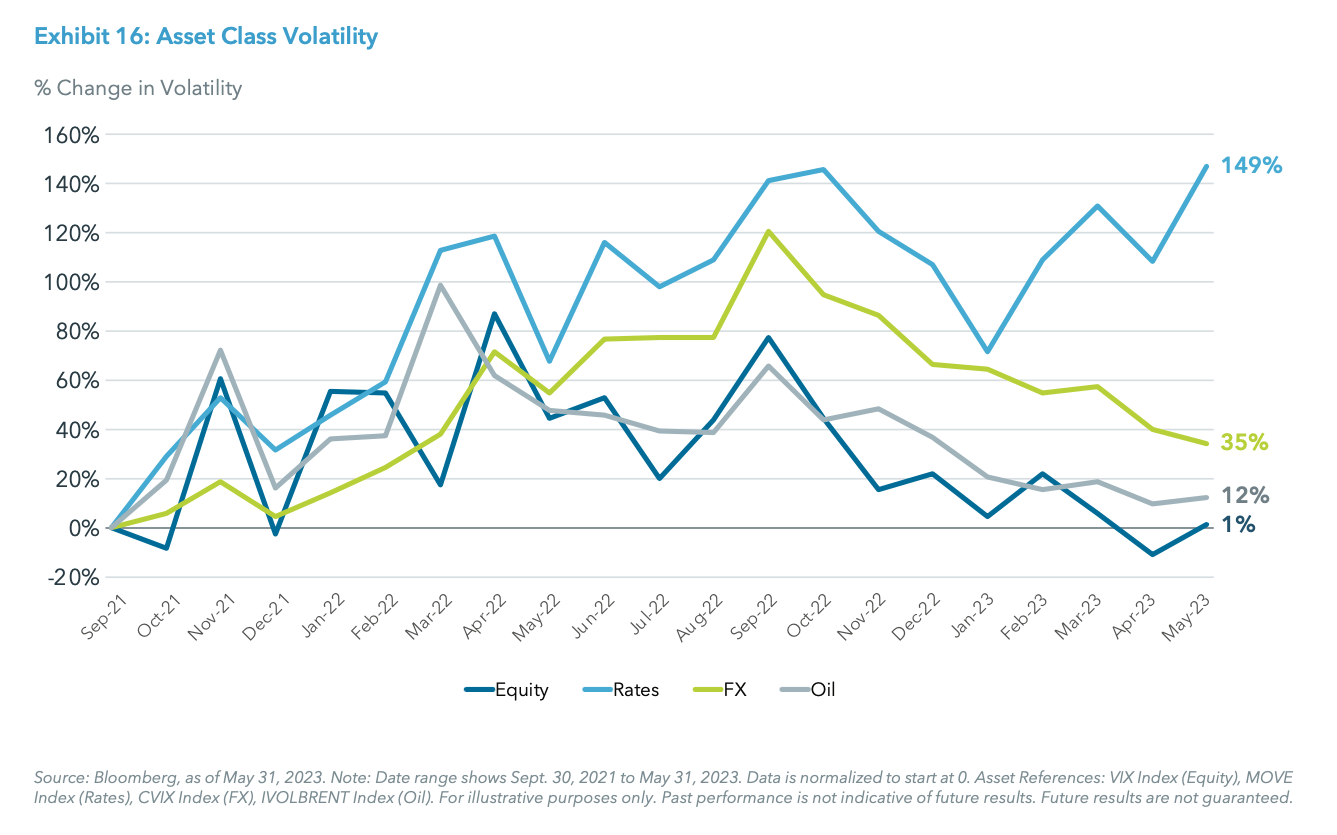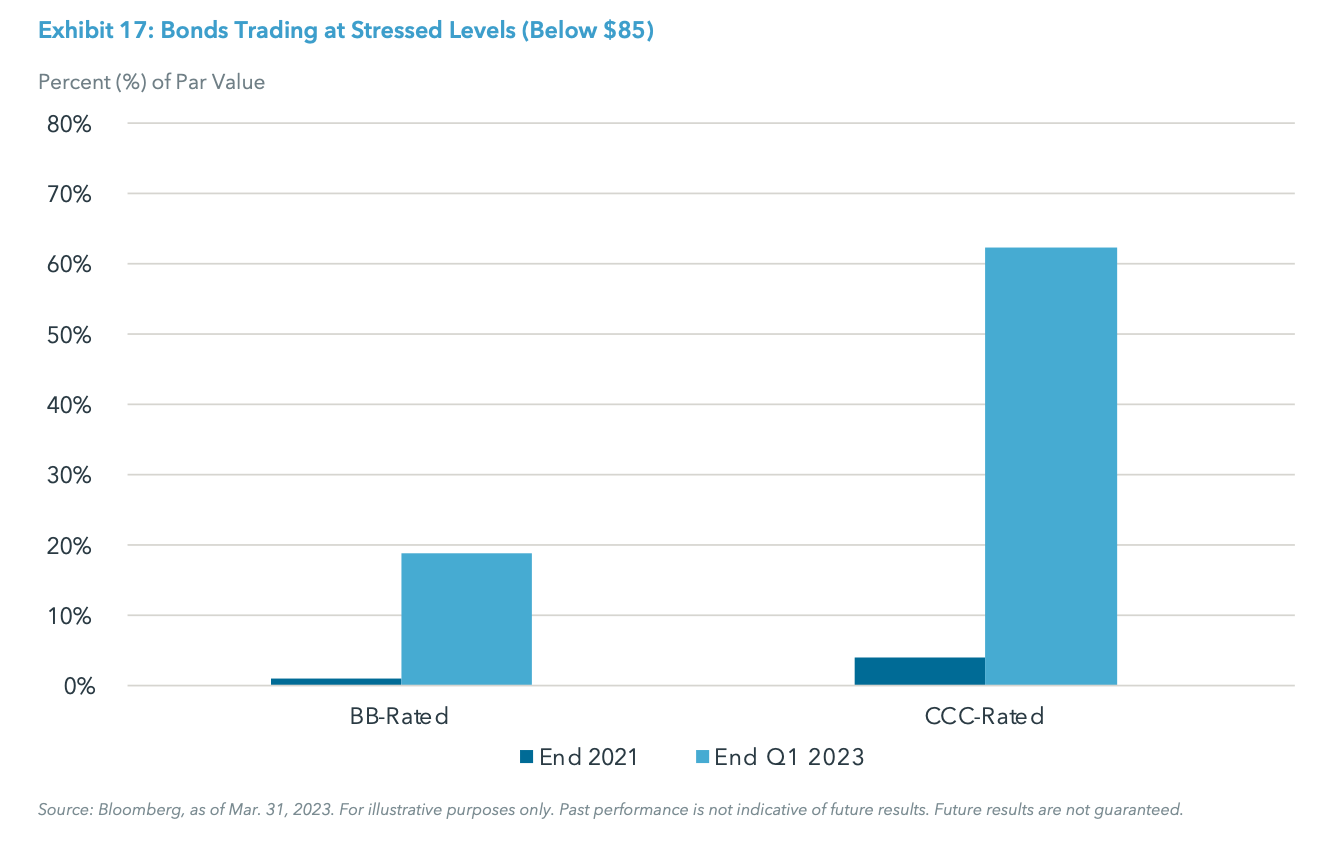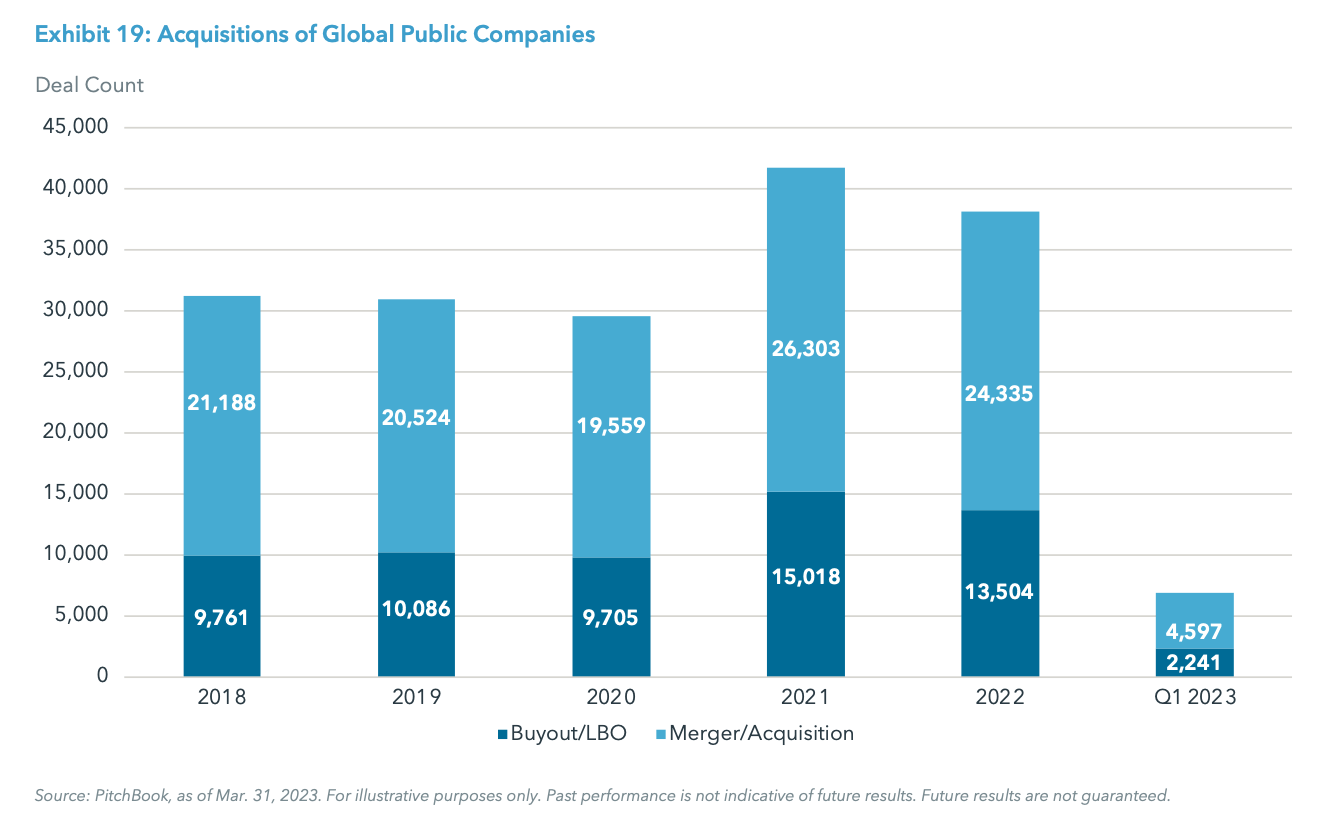EXECUTIVE SUMMARY
PRIVATE EQUITY
LARGE BUYOUT
Current Outlook – Neutral
Trend versus Q4 2022 – Same
Large buyout returned approximately -6% in 2022 (compared to -19% for the S&P 500 Index over the same period), after a very strong 2021 when the category returned over 45%.1 Over a 15-year period, the large buyout category has generated a steadfast 11.9% IRR.2 The historically dependable return profile has allowed the category to continue to increase its share of the overall private equity fundraising market in a more challenging environment. As of December 31, 2022, the capital raised by private equity managers in the U.S. with fund sizes greater than $5 billion reached over $178 billion, a 10.2% increase compared to 2021.3 Relative to the overall capital raise of $343 billion in the U.S. in 2022, large buyout accounted for more than 50% of the overall buyout sector for the year— for the first time since 2009.4 As investors continue to favor larger funds from more experienced managers relative to the smaller counterparts, the trend is likely to continue throughout 2023.
At the same time, higher interest rates have been driving a significant drop in syndicated financing for larger buyouts, resulting in increased broken deals and reduced exit valuations. Exit value for large buyout has dropped by over 80% in 2022 (as compared to 66% for the overall buyout sector).5 Public listings, one of the primary exit routes for the category, accounted for 11% of the large buyout exit value (under 3% of the total exit value) for the period, a significant drop from the 10-year average of 55% (under 17% of the total exit value).6 For those who need liquidity, they may have to settle for less as median buyout EV/EBITDA multiples dropped from 11.8x in 2021 to 9.9x entering 2023.7 Conversely, the valuation reset is potentially creating attractive opportunities for large buyout funds with significant dry powder to deploy.
Risks: Slowing economic growth and potential recession; likely valuation multiple contraction at exit; impact of higher borrowing cost; high inflation impacting portfolio company margin.
MIDDLE MARKET BUYOUT
Current Outlook – Positive
Trend versus Q4 2022 – Same
Middle market activity moderated in 2022 from the record-breaking level of 2021, but remained healthy by historical standards. Through the end of 2022, U.S. middle market activity totaled approximately $440 billion across 3,314 transactions, marking a 26% and 21% decrease, respectively, year-over-year (YoY).8 Continued market volatility and elevated interest rates in 2023 could cause deal activity to remain flat or even fall compared to last year.
While the exit environment in 2022 for middle market deals has been materially worse compared to the record year in 2021, companies continued to be sold to financial sponsors and strategic acquirers for a total of $141 billion (47% YoY decrease), which is higher than the historical average of $140 billion.9 Public listings have not been a major exit route for middle market buyout historically, and as such, despite the continued weakness in the equity capital markets, their impact on the sector is rather muted.
Although the macro environment is challenging, we continue to view middle market companies as typically less mature and often operationally inefficient, meaning there are more opportunities to generate returns by improving operations and growing revenues by adding product lines, expanding geographically, and executing accretive mergers and acquisitions (M&A). Companies are also often domestic in nature, limiting the potential impact from geopolitical instability or currency fluctuation. Case in point, the Golub Capital Altman Index (GCAI), which tracks PE-backed middle-market companies, reported 10.8% and 9.2% YoY revenue and earnings growth for the first two months in Q4 2022, respectively.10 This compares well to a 5.4% increase in revenue and a 4.8% decrease in earnings for the S&P 500 YoY.11 Middle market companies also benefit from a larger buyer universe (including sponsors) who have access to private lending markets that are less reliant on broadly syndicated financing. These companies are also valuable strategically given their high levels of growth.
Risks: Slowing economic growth and potential recession; multiple contraction due to higher borrowing costs and slower growth; supply chain issues.
SECTOR-FOCUSED BUYOUT
Current Outlook – Positive
Trend versus Q4 2022 – Same
Capital raised for sector-focused funds has grown significantly in recent years according to PitchBook data.12 Specialized sponsors often have advantages over their generalist peers when it comes to sourcing, market intelligence, and ability to navigate sector-specific complexities. Against a challenging macro backdrop, not all sector specialists are positioned equally. Those focusing on consumer products and services and commodity-driven businesses face significant headwinds from the impact of inflation, rising rates, and potential economic slowdown. However, in our view, those focused on defensive sectors and secular growth trends with tailwinds across market cycles (e.g., healthcare and technology) are likely best placed.
Secular trends and adoptions of technology across sectors, as well as the high renewal rates and the recurring nature of software, make the sector attractive. Technology-focused deals accounted for 50% of all $100m+ transactions in Q1 2023, representing a fifth straight yearly increase in share.13 Within technology, areas of focus are cybersecurity and data and analytics. Given the current market environment, corporate spending is expected to moderate. However, chief information officers anticipate increasing their spending on domains such as cybersecurity, data and analytics, and automation.14 Also, as valuations continue to come down in private markets, and, specifically in technology, there are more opportunities to acquire high quality assets at compelling prices.
Healthcare remains attractive, due to demographic drivers, increasing adoption of digital health/healthcare information technology (IT), growth in value-based care, and heightened awareness emerging from the pandemic. Many subsectors within healthcare are largely insulated from changes in consumer spending and are perceived as more resilient across cycles. According to PitchBook data, healthcare M&A represented 16% of total estimated global deal value through Q1 2023, a 43% increase from 2022.15
The current dislocation in the public equity markets, particularly in the technology sector, should continue to impact private market valuations in the coming quarters. Given the timing and information lag inherent in private markets, this dynamic is unlikely to have been fully realized at the deal level, and further contractions in multiples are expected. While this may lead to multiple compression in existing portfolios, a valuation reset should also create an attractive buying environment for sector specialists. On balance, we believe the opportunities emerging from the recent market dislocation outweigh the macro pressures, particularly in more resilient sectors like technology and healthcare.
Risks: Slowing economic growth and potential recession; impact of higher borrowing costs and inflation; likely contraction in valuation multiples at exit.
GROWTH EQUITY
Current Outlook – Neutral
Trend versus Q4 2022 – Same
U.S. growth equity deal activity fell in 2022, but both deal count and deal value exceeded 2020 and prior years, indicating that public equity market corrections have not yet had a meaningful impact on their private market counterparts. Given the significant correction of high- growth publicly traded technology stocks, we believe privately held growth companies will be unable to avoid the aftershocks.
The funds that are most at risk include those with sizable active portfolios and limited realizations that have deployed capital in the high-valuation environment over the past few years. These funds will face a more challenging macro environment which could have an adverse impact on company operations, the ability to raise capital, and holding periods. In addition, as private valuations catch up to public valuations over the next few quarters, we are likely to see significant performance dispersion within the category as certain companies will be better positioned than others, depending on financial or operational discipline, resilience of business models, and target end markets (among other factors).
While we are beginning to see a slowdown in growth, we are, however, starting to see more investor-friendly terms. According to PitchBook, supply and demand dynamics between companies and investors are shifting in the favor of investors. The shift in median ownership share for new investors increased from 10% in Q2 2022 to 17% in Q4 2022, and cumulative dividends made a resurgence.16 Now that capital is more constrained, investors have more time to analyze deals and more levers to pull in terms of pricing.
Risks: Slowing economic growth and potential recession; valuation multiple contraction likely at exit; and slowdown in exit activity due to closed initial public offering (IPO) markets.
LATE-STAGE VENTURE CAPITAL
Current Outlook – Negative
Trend versus Q4 2022 – Same
Late-stage venture deal value and deal count declined quarter-over-quarter in 2022 after peaking in Q3 2021 and Q1 2022, respectively. Q1 2023 deal value was down over 70% from the peak in Q3 2021, and also nearly 30% below the 2018-2020 average.17 These metrics represent a steeper reversal than seen across other stages of venture (e.g., early-stage), which is unsurprising given that later- stage venture tends to be more cyclical in nature and tied more closely to the public markets, which experienced a significant drawdown in 2022, with the technology-heavy Nasdaq down 33.1%.18
Late-stage median pre-money valuations saw a nearly 23% decline in Q1 2023 compared to 2021.19 Q1 2023 median pre-money valuations were still over 50% above the 10-year median, however, representing a more attractive spread compared to early-stage and seed median valuations, which were still approximately 100% above long-term averages in Q1 2023. Relatively speaking, valuations remain high, but are beginning to look more attractive. Another benefit of the current market is that companies today are becoming much more disciplined in terms of cash burn and are focused on profitability, which is a significant change from the growth at all costs mantra of 2021. Finally, non-traditional investor and crossover investor participation has fallen by nearly 70% from its peak in terms of both volume and activity.20 Additionally, in 2021 (peak venture activity) deals with non-traditional investor and crossover investor participation were on average 4x larger than the average for all deals in 2021.21 With the departure of these “tourist” investors, we expect the venture ecosystem to continue to normalize in the coming quarters.
That said, one of the more important drivers of late-stage venture performance is the exit environment, which has been significantly challenged over the past year. In 2021, the U.S. venture capital market saw a staggering 1,900+ exits representing over $750 billion in exit value. That is over 5.5x greater than the average annual exit value between 2013-2020.22 Even when looking beyond 2021, which was truly an outlier year, Q1 2023 annualized exit value is on pace to be nearly 90% below the 2018-2020 average and over 70% below the 2013-2017 average.23 The uncertainty around the IPO window will continue to be a headwind to late-stage venture.
Risks: Valuation concerns, public market volatility, and uncertainty around exit environment.
EARLY-STAGE VENTURE CAPITAL
Current Outlook – Neutral
Trend versus Q4 2022 – Same
Early-stage venture deal count and deal value continue to decline after peaking in Q1 2022 and Q4 2021, respectively. Through Q1 2023, transaction volume as well as the number of transactions has fallen approximately 67% and 40%, respectively.24 While these figures represent a significant drop, it is important to note that this decline represents a normalization in activity rather than a trough, as shown in Exhibit 6.
We see a similar story with median pre-money valuations, declining over 20% from the highs in 2022.25 This should not be surprising, given the sharp sell-off seen in publicly traded technology companies, as illustrated by the Nasdaq’s 33.1% drop in 2022.26 In our view, the exuberance experienced in 2021 and early 2022 within venture capital has clearly abated and the sector is trending towards longer term averages in terms of activity and pricing. Fundraising, on the other hand, has fallen dramatically from both recent highs and normalized levels. Venture capital fundraising in Q1 2023, on an annualized basis, was down nearly 62% from 2021 highs, as well as 58% and 14% below 2018-2020 and 2013-2017 averages, respectively.27 The challenging fundraising environment does offer benefits to new investors, as historically access- constrained general partners (GPs) become more amenable to new investors. Additionally, the environment today offers other positives, including more attractive valuations, smaller fund sizes, more disciplined investment pacing, and potentially more efficient companies that now must operate in a much tighter environment. Finally, early-stage venture is less about market timing and more about the market opportunity to access some of the world’s most innovative new companies at the earliest stages of their lifecycle.
With that being said, there is still a degree of uncertainty when it comes to the venture landscape, as price discovery continues to unfold and venture capital managers remain focused on working with existing portfolio companies (representing billions of unrealized investor gains) to navigate the current environment. Additionally, while the venture ecosystem has largely moved past the regional bank crisis unscathed, this event did result in significant short-term turmoil and the venture ecosystem could face continued headwinds from a challenging fundraising environment, economic uncertainty, and a potential recession.
Risks: Higher loss rates, valuation concerns, and longer hold periods.
SECONDARIES
Current Outlook – Positive
Trend versus Q4 2022 – Same
Global secondaries deal volume in 2022 remained strong, illustrating the ongoing need for liquidity options, even though there was a decline in 2022 of 18% from a record year in 2021 ($132 billion in 2021 compared to $108 billion in 2022).28 This was due in part to a widening of the bid-ask spread, as well as buyers being more selective as a result of the valuation disconnect between public and private companies and the backdrop of market volatility.
In 2022, secondary transactions led by limited partners (LPs) accounted for 52% of total secondaries volume, representing a larger share of the market than GP-led transactions for the first time since 2019.29 In fact, about 50% of all LP sellers were first-time sellers, illustrating LPs’ desire to rebalance their portfolios, particularly in a slower distribution environment, for those that were over allocated to private equity.30 Consequently, the average pricing for LP-led portfolios was 81% of net asset value versus 92% of net asset value in 2021.31 With regards to GP- led secondaries, this segment of the market encountered a 24% contraction in 2022 from the previous year, but was still higher by 49% than the volume reached in 2020.32
Secondaries fundraising has maintained a healthy momentum given that capital raised in Q1 2023 reached nearly $31 billion, almost 67% of the prior year’s total of $46 billion.33 The large amount of capital has led secondaries dry powder to reach roughly $171 billion through 2022, of which $111 billion is from funds that were launched in the past two years.34
Given the uncertainty in the current market environment, traditional LP secondaries continues to be an avenue for allocators to offload fund stakes at potentially considerable discounts to generate liquidity, allowing secondary firms to acquire diversified assets at attractive prices. Should the denominator effect persist, secondaries deal volume could amplify. In addition, GPs continue to seek GP-led secondaries to hold on to desirable assets rather than having to sell these assets in unfavorable market conditions.
We believe incorporating secondaries into a portfolio can be a valuable risk-mitigating tool by reducing the J-curve effect, typically generating a faster distribution pace and return of capital, and a reduced blind pool risk at the asset level.
Risks: Heightened competition following several years of record fundraising; less potential for alpha due to narrower dispersion of returns; heightened overall PE market risks due to increasing interest rates and the potential for slower growth; softer impact from the denominator effect should future market volatility be subdued.
PRIVATE DEBT
PRIVATE CREDIT
Current Outlook – Neutral
Trend versus Q4 2022 – Same
The Cliffwater Direct Lending private credit benchmark produced a positive (albeit somewhat muted) 7.3% return over the last twelve months through Q1 2023. That is 4.3% lower than the return over the previous twelve months.35 The impact on return is largely due to mark-to-market as yields have climbed in the last year. The macroeconomic environment remains difficult and there are increased headwinds for private credit in the near-to-medium term. Direct lending opportunities for sponsor-backed transactions are fewer in 2023, amidst lower levels of private equity investment activity. U.S. private equity deal value totaled over $84 billion in Q1 2023, retreating substantially from the elevated levels touched in the same period in 2021 and 2022.36 However, buyout dealmaking activity may have troughed, which in turn should lead to a greater opportunity set for private credit managers to deploy their $193 billion of direct lending dry powder.37
Amidst the more challenging deployment environment, private credit also faces increased credit risks. While lenders are mostly insulated from duration risk due to the floating rate structure of most loan packages, they can only pass on a certain increase in yield without over- burdening their portfolio companies who face potentially slowing or even contracting EBITDA growth as economic activity softens, potentially leading to higher defaults. Fitch Ratings’ U.S. LevFin Default forecasts for 2023 for non- financial companies already rose from 2.5-3.0% in January 2023 to 4.0-4.25% in their May 2023 report.38
Despite a more difficult environment, we believe private credit can still play an important role in client portfolios, providing attractive absolute return and yield. In fact, with rising base rates, yield to investors is materially higher today than in 2022. The Cliffwater Direct Lending Index (CLDI) distribution yield now stands at 10.95%, up from 8.7% in Q1 2022.39 Investor protections have also increased in the current environment with new loans being underwritten with lower leverage levels and tighter terms, which is particularly constructive for new issue loans. Moreover, we believe the buy-and-hold nature of private credit should help shelter investors from the volatility felt by public fixed income investors. Within this space, we continue to favor established managers who have strong relationships with repeat borrowers and have demonstrated a disciplined approach to underwriting.
Risks: Elevated interest rates and risks of a recession; risk of higher defaults; and greater direct lending competition.
DISTRESSED DEBT/SPECIAL SITUATIONS
Current Outlook – Positive
Trend versus Q4 2022 – Same
The Fed has aggressively raised rates in 2022 and 2023 in reaction to persistent high inflation and tight labor markets, bringing the Fed Funds target rate range to 5.0-5.25%—the highest level since July 2007.40 The magnitude and pace of the interest rates hikes is likely to put economic growth under pressure and create difficulties for companies to service their debt due to higher interest payments. The impact of weakening credit quality could create a rich opportunity set for distressed debt and special situations given the dramatic increase in the size of credit markets—growing three times larger since 2008 to $5.1 trillion.41
Signs of credit stress are emerging with the failures of regional banks, highlighting the potentially unexpected outcomes of increasing and elevated interest rates. Cracks in regional banks also have serious knock-on effects as lending standards tighten across the financial system, making refinancing maturing debt difficult for highly levered companies. We are already experiencing increasing defaults in corporate credit with the Proskauer Credit Default Index, covering middle-market companies, showing a default rate of 2.06% for Q4 2022, up from 1.56% in Q3 2022, including a significant uptick in stress among consumer goods and service sectors and healthcare.42 Further, Fitch Ratings is forecasting the default rate for non-financial companies to jump to 4.0-4.25% over the coming 12 months from the 2.5-3.0% default rates we witnessed at the end of January 2023.43
The positive environment for distressed is expected to remain robust for the foreseeable future. Compared to 2020, when distressed opportunities were largely short- lived due to unprecedented monetary and fiscal stimulus. Similar interventions today are likely to be far more constrained given sustained high inflation levels, higher rates, and elevated debt/GDP ratio. That said, the schedule of maturating debt could postpone anticipated defaults as many companies were able to extend the maturities of their debt by refinancing in the low rate environments prior to 2022. However, the prevalence of covenant-lite loans may also provide companies more flexibility in a downturn potentially creating a situation that if and when defaults do happen, it could cause recovery values to be lower than in the past, where earlier triggers have historically helped limit borrower losses. For this reason, we expect managers with experience leading restructuring processes and taking an active approach to outperform passive strategies.
Risks: Uncertain timing and scale of go-forward opportunity set, fiscal, and monetary stimulus.
REAL ASSETS
REAL ESTATE
Current Outlook – Neutral
Trend versus Q4 2022 – Same
The current macro environment is potentially challenging for commercial real estate. Softer economic growth, as we have seen in 2023, can impact affordability and net operating income, while rising interest rates could begin to push up cap rates (after a lag), resulting in lower commercial real estate (CRE) valuations on investors’ existing portfolios. The NCREIF National Property Index (NPI) posted a decline in the first quarter of -1.81% after posting its worst return since 2009 in the fourth quarter of 2022 at -3.50%.44 Cap rate expansion has been a key driver of this negative performance; however, cap rate spreads remain tight to fixed income and could see further pressure on existing prices.
Additionally, the outlook for real estate sectors remains divergent. Residential investments continue to be supported by limited housing supply, rising mortgage rates, and tight homeowner lending standards. The industrial sector continues to benefit from the secular tailwinds of e-commerce adoption and the move to just- in-time delivery. The office sector continues to feel the pressure of oversupply and higher vacancies, as the market has not fully recovered from COVID. National vacancy rates sit at 17.8%, well above pre-pandemic levels closer to 13% and the highest level in 30 years.45 Additionally, the sector tends to contract into longer leases with its tenants, limiting the inflation hedging success for those investments.
Against this backdrop, we see a widening of the opportunity set between core and value-add/opportunistic CRE strategies. Core real estate emphasizes income yield as a key driver of its attractiveness, so an environment that reduces the relative value of income yield to fixed income alternatives could be negative for this strategy. In addition, low transaction volumes and wide bid/ask spreads in existing real estate are forcing sellers to take deeper discounts on their properties. Further, stress in the regional banking system, which accounts for 70% of the CRE lending market in the U.S., will make refinancing more challenging and deemphasize “kicking the can down the road,” particularly in troubled sectors like the office sector.46 The more attractive risk-reward proposition may be further up the risk spectrum in value-add and opportunistic real estate, which can offer better total return profiles given their additional paths to return on investment, including renovations and repositioning, as well as potentially better pricing. Additionally, new vintages of value-add and opportunistic strategies have the benefit of putting dry powder to work in this environment and potentially capitalizing on market stress.
Risks: Rising inflation and interest rates weighing on economic growth and affordability of lessees, and valuation contraction.
INFRASTRUCTURE
Current Outlook – Neutral
Trend versus Q4 2022 – Same
Historically, infrastructure has been resilient during periods of above-average inflation as many sub-sectors are able to pass on rising costs to the end customer. Between 1999 and Q2 2022, North American infrastructure performance during periods of elevated inflation (>3%) exceeded performance during all periods by over 600 basis points (bps).47 However, the term infrastructure covers a broad category of investments and geographies, from toll roads to cell towers, and its value as an inflation hedge depends on the type of assets purchased. For example, infrastructure sectors with closer ties to energy, materials, and transportation/industrial end markets tend to benefit more from rising prices than those with direct utilities or communications services exposure. Furthermore, rising interest rates may affect the relative attractiveness of core infrastructure as an income investment, as single-digit yields look less compelling with 10-year U.S. Treasury rates yielding over 3%.48
Today, governments globally recognize the need to rebuild and enhance their infrastructure. The Inflation Reduction Act in the U.S. is expected to provide more than $4.1 trillion in cumulative capital investment in new U.S. energy infrastructure over the next decade. Europe’s need to expand its renewable energy capacity as a substitute for Russian oil and gas should spur infrastructure investment opportunities on the continent. Lastly, we believe the continued growth in data usage and cloud services represents a secular tailwind for digital infrastructure. That said, some areas of infrastructure are more GDP-sensitive than others, such as transportation and energy, and may be challenged in a recessionary environment, though the monopolistic and concession-driven nature of many of assets (airports, bridges, toll-roads, pipelines, etc.) can help buffer some of the potential economic downturn.
Infrastructure fundraising remained robust in 2022, with over $100 billion raised.49 This included $30.9 billion raised by value added infrastructure funds, roughly in line with the amounts raised by core and opportunistic funds, and a substantial increase compared to 2020 and 2021.50 Overall, fewer infrastructure funds came to market in 2022 compared to 2021, with only a slight drop in total dollars raised, indicating that more assets are concentrated in larger mega-funds. Indeed, according to PitchBook, $71.3 billion was raised by funds with $5+ billion of AUM in 2022, up from $55.3 billion raised by $5+ billion-AUM funds in 2021.51 However, fundraising activity slowed dramatically in Q1 2023, with six funds closing on a total of $2 billion – the lowest quarterly figure in a decade.52
Risks: Economic slowdown weighing on the value of incremental projects, and heightened valuations of existing assets limiting returns for core funds that are acquiring.
ENERGY
Current Outlook – Neutral
Trend versus Q4 2022 – Same
Energy largely retraced from its 2022 highs, with WTI Crude Oil settling into a trading range of $60-$85 per barrel (bbl) throughout 2023.53 While pricing levels are roughly half of where they were at the peak of 2022, current levels have been less volatile and well above production costs, making the sector profitable for upstream companies. Natural gas pricing has also fallen significantly from its 2022 peak of $10 per MMBtu following the start of the Russian-Ukraine conflict, and settled into a trading range of $2-$3 per MMBTu.54 The current pricing of $2.34 per MMBTu sits below the cost of production for many of the dry gas basins and might make investment in this part of the ecosystem less attractive.55 The rest of the energy ecosystem continues to evolve from traditional fossil fuel investment to energy transition, led by renewable power generation with wind and solar as well as storage for both.
The outlook for the asset class remains mixed going forward. Years of declining energy capacity due to poor returns and ESG concerns have led to structural under investment. Additionally, the shift of the Organization of the Petroleum Exporting Countries (OPEC), going from taking market share with higher production rates to curbing production, should benefit oil prices and production profitability going forward. On the other hand, high interest rates and the potential for slowing global demand could shift the supply/demand dynamics and reduce the attractiveness of the space, while renewables continue to take market share for new electric-generating capacity. In 2023, renewables accounted for 82% of new, utility-scale capacity that developers plan to bring online in the U.S.56
Risks: Global central banks raising interest rates to fight inflation could slow economic growth, bringing supply and demand back into balance. Unpredictable supply side issues concerning OPEC’s approach.
INTERNATIONAL
EUROPE
Current Outlook – Neutral
Trend versus Q4 2022 – Same
On the back of lower energy prices and a strong labor market, the EU experienced GDP moderate growth in Q1 2023, lifting the outlook for full-year 2023 to 1.0% and to 1.7% in 2024. In the U.K., the Bank of England has revised the country’s growth forecast upward to 0.25% in 2023 and 0.75% in 2024.57 At the same time, inflation in the European Union has started to slowly come down, with the Consumer Price Index (CPI) running at 5.5% in June.58 However, despite predictions it would fall, the CPI remained high in the U.K. at 8.7% in May 2023.59 While the European Central Bank is thought to be nearing the end of the interest rate hiking cycle, the U.K.’s Bank of England remains under pressure for further rises.
After peaking in Q2 2022, European deal activity continued to drop, decreasing by 6.8% YoY in terms of deal value as of Q1 2023.60 However, deal count has remained resilient suggesting that fund managers are favoring smaller add-ons over megadeals.61 Such transactions accounted for 59.8% of overall deal count in Q1 2023, substantially more than the 10-year average of 44.7%.62 Higher interest rates are also prompting GPs to be more conservative with the use of leverage and lowering the propensity to pay high multiples. In 2022, the median PE buyout in Europe was acquired with debt financing almost three turns of EBITDA less than the previous year (4.8x vs. 7.5x), despite the same amount of equity (6.5x vs. 6.4x).63 The volume of exits was down 30% in 2022, with a dormant IPO market accounting for only 1% of buyout exits, down from 16% in 2021.64 On the fundraising side, the number of new funds launched dropped 60% in 2022, as many GPs chose to delay fundraising.65 Within the abovementioned context, we remain neutral on our outlook for Europe.
Risks: Inflationary environment; rising rates; higher borrowing costs; mortgage crisis in Southern Europe; political volatility; and escalation of the conflict in Ukraine.
ASIA
Current Outlook – Neutral
Trend versus Q4 2022 – Same
Asia-Pacific’s gross domestic product is expected to expand 4.6% in 2023, after growing 3.8% in 2022.66 The International Monetary Fund (IMF) predicts China and India will contribute around half of global growth this year, with another fifth contributed by the rest of Asia-Pacific. Inflation in the region has been less pronounced than in the U.S. and Europe, and as a result Asian central banks have embarked on more modest policy tightening. On the geopolitical side, the region continues to experience headwinds, with strained relationships between U.S. and China often leading to a series of tit-for-tat policy actions.
After a record 2021, and the first half of 2022 during which deal activity was roughly on par with 2021, private equity activity in Asia collapsed in the second half of 2022. Deal value during 2022 fell 44% to $198 billion; exits and fundraising also dropped by over a third over the same period.67 Greater China suffered the largest contraction in deal activity in the region, declining over 53% YoY.68
From a sector perspective, industries such as advanced manufacturing, energy, and natural resources benefitted from higher flows, while despite remaining the region’s largest investment sectors, internet and technology reached a five-year low in terms of share of deal value.69 Despite fundraising for private capital funds falling 39% to $139 billion70 in 2022, dry powder in Asia rose to a record $676 billion.71 On balance, we remain neutral on our outlook for the Asian region.
Risks: The region continues to provide investment opportunities, but cross-border complexities, ever- tightening regulation and escalating geopolitical tensions will make investors cautious.
HEDGE FUNDS
MULTI-STRATEGY
Current Outlook – Positive
Trend versus Q4 2022 – Same
Multi-strategy funds preserved capital in 2022, with the HFR RV: Multi-Strategy Index down -0.7%, despite the sharp decline in risk assets, and produced modest gains in the first quarter of 2023 (up 1.7%).72 With an emphasis on diversification and maintaining limited directional exposure, the group has continued to deliver steady performance with little correlation to traditional assets.
Higher interest rates and slowing economic activity have contributed to wider dispersion among individual security issuers, creating an attractive backdrop for relative value trading opportunities. Firms who employ a diverse group of specialist teams can invest broadly across asset classes, sectors, and geographies. Because these teams are in-house, the investment/capital allocation committees of these firms are well-positioned to rotate capital amidst an evolving market opportunity set. Given the competition for investment talent, the leading multi-manager firms continue to differentiate themselves through their growing capital bases, extended liquidity terms, flexible compensation structures, and access to research and support resources.
Robust investor demand for multi-strategy funds has continued. Managers’ willingness to match their asset growth with their investment capacity will be critical to their ongoing success.
Risks: Dampened volatility across asset classes; lower dispersion/higher correlation among individual issuers; unbalanced or excessive risk factor exposures; growing competition for investment talent; and unconstrained AUM growth.
MACRO
Current Outlook – Positive
Trend versus Q4 2022 – Same
Macro strategies generated strong returns in 2022, with the HFR Macro Index up 9.0%, led by trading in global rates and currencies. Results in the first quarter of 2023 have been challenged (down -2.4%) as certain investment themes have reversed course amid a rally in risk assets.73
Overall asset class volatility continues to trend higher, and there has been a greater degree of “vol-on-vol” choppiness across markets. With a slowing global economy and an uncertain inflation/interest rate outlook, volatility levels are likely to remain on a higher plateau in the coming quarters.
Varied fiscal and monetary responses across geographies continue to add complexity to the macro environment. As the impact of these diverse policies ripples across markets, the backdrop should provide attractive trading opportunities for macro strategists. The dispersion of individual fund returns among macro practitioners remains wide, highlighting the importance of manager selection in the segment.
Risks: Dampened volatility across assets; sharp reversals in key investment themes; converging fiscal and monetary policies globally; return to “easy money” by global central banks; and uncertain impact of anti- globalization/protectionist policies.
CREDIT
Current Outlook – Positive
Trend versus Q4 2022 – Upgrade
Credit funds finished modestly lower in 2022, with the HFR Credit Index down -2.6%, as global central bank tightening pushed yields higher across the bond market. Funds have generated small gains in the first quarter of 2023 (up 1.6%) as the headwinds of duration risk have somewhat subsided.74 While the current tightening cycle may be nearing an end, higher rates and continued economic uncertainty are likely to result in greater dispersion among issuers. This should create opportunities for established firms with strong credit risk underwriting capabilities, particularly those with expertise in debt restructurings and reorganizations.
The backdrop for securitized credit is mixed. Consumer- facing credits are facing headwinds as household balance sheets become stretched, while weakness in certain real estate segments (e.g., the office sector) is weighing on commercial mortgaged-backed securities, which faces a ~$1.5 trillion maturity wall by the end of 2025.75 That said, managers who can source primary deals and negotiate favorable transaction terms should be able to capture the higher yields that the current backdrop presents.
In the municipal bond markets, headwinds stemming from rising rates and technical selling pressure have abated, allowing specialist managers to potentially take advantage of attractive, tax-advantaged yields from high- quality issuers.
Risks: Economic slowdown/recession; sharply widening spreads and a steeper default cycle; low dispersion and dampened volatility across fixed income; and abrupt changes in liquidity in certain segments.
EQUITY HEDGE
Current Outlook – Neutral
Trend versus Q4 2022 – Same
Equity hedge funds struggled in 2022, with the HFR Equity Hedge Index down -10.1% amidst the sharp sell-off in global equities, particularly among growth- oriented issuers. In 2023, equity hedge funds have returned to profitability (up 2.5% in the first quarter), but have been challenged by narrow equity market leadership in the U.S.76 As macro influences (notably the direction of interest rates) begin to abate, investors may increasingly focus on company-specific fundamentals. Combined with the mixed outlook for corporate earnings, this should result in an improving backdrop for long-short stock picking.
Quantitative strategies have generally outperformed their fundamental counterparts by taking advantage of market dispersion while limiting factor and style biases within portfolios. The outlook for these strategies remains promising as higher dispersion is likely to persist amidst a slowdown in the global economy.
Market performance across geographic regions is likely to vary as governments respond to changes in the outlook for inflation and economic growth. This should give an edge to managers who can source opportunities on a global basis.
Risks: Beta headwinds overshadow alpha generation; economic slowdown/recession in U.S. and abroad; macro factors dominating company fundamentals; falling dispersion among individual issuers; and sharp style and factor imbalances (e.g., growth vs. value).
EVENT DRIVEN
Current Outlook – Neutral
Trend versus Q4 2022 – Same
Event driven funds posted modest losses in 2022, with the HFR Event Driven Index down -4.8% as the slowdown in capital markets activity hampered the strategy. Funds started 2023 on a positive note (up 1.4% in the first quarter of 2023), with the rebound in risk assets compensating for a continued lackluster backdrop for dealmaking.77 Overall, capital markets activity remained tepid in Q1 2023, as tighter financial conditions and economic uncertainty continued to weigh on the deal calendar.
Transactions involving public companies are on pace to fall for the second straight year. Through the first quarter of 2023, buyouts were trending towards a -35% YoY decline, while M&A activity was on pace to sink -24% YoY.78 If these trends hold, it would be the sharpest decline in overall activity since 2009.79
Funds that have the flexibility to invest across the capital structure may be well-positioned to take advantage of special situations in both equities and credit. Additionally, managers who can create their own catalysts—such as through shareholder activism—are likely to have an advantage should capital markets remain constrained.
Risks: Tight financial conditions/economic uncertainty further constrain capital markets activity; “beta overshadows alpha” as events/catalysts are offset by market volatility; and more restrictive regulatory backdrop dampens dealmaking.
ENDNOTES
1. PitchBook, as of June 15, 2023.
2. PitchBook, as of June 15, 2023.
3. PitchBook, 2022 Annual Global Private Markets Fundraising Report, February 22, 2023.
4. PitchBook, 2022 Annual U.S. PE Breakdown, January 12, 2023.
5. PitchBook, 2022 Annual U.S. PE Breakdown, January 12, 2023.
6. PitchBook, 2022 Annual U.S. PE Breakdown, January 12, 2023.
7. PitchBook, Q1 2023 U.S. PE Breakdown, April 11, 2023.
8. PitchBook, 2022 Annual U.S. PE Middle Market Report, March 14, 2023.
9. PitchBook, 2022 Annual U.S. PE Middle Market Report, March 14, 2023. Historical average including data from 2007-2022.
10. PitchBook, 2022 Annual U.S. PE Middle Market Report, March 14, 2023; Golub Capital, Q4 2022 Middle Market Report, January 12, 2023.
11. PitchBook, 2022 Annual U.S. PE Middle Market Report, March 14, 2023; Factset, Earnings Insight, February 24, 2023.
12. PitchBook, Q1 2023 U.S. PE Breakdown, April 11, 2023.
13. Ernst & Young, EY Private Equity Pulse: Takeaways from 1Q 2023, May 1, 2023.
14. McKinsey & Company, Private Equity Turns to Resiliency Strategies for Software Investments, March 29, 2023.
15. PitchBook, Q1 2023 U.S. PE Breakdown, April 11, 2023.
16. PitchBook, Q1 2023 U.S. PE Breakdown, April 11, 2023.
17. PitchBook-NVCA Venture Monitor, as of March 31, 2023.
18. eVestment, as of December 31, 2022.
19. PitchBook-NVCA Venture Monitor, as of March 31, 2023.
20. PitchBook-NVCA Venture Monitor, as of March 31, 2023.
21. PitchBook-NVCA Venture Monitor, as of March 31, 2023.
22. PitchBook-NVCA Venture Monitor, as of March 31, 2023.
23. PitchBook-NVCA Venture Monitor, as of March 31, 2023.
24. PitchBook-NVCA Venture Monitor, as of March 31, 2023.
25. PitchBook-NVCA Venture Monitor, as of March 31, 2023.
26. eVestment, as of December 31, 2022.
27. PitchBook, Q1 2023 Global Private Market Fundraising Report, May 24, 2023.
28. PitchBook, PitchBook Analyst Note: The Evolution of the Private Markets Secondaries, April 20, 2023.
29. Jefferies, Global Secondary Market Review, January 2023.
30. McKinsey & Company, McKinsey Global Private Markets Review 2023, March 21, 2023.
31. Jefferies, Global Secondary Market Review, January 2023.
32. Jefferies, Global Secondary Market Review, January 2023.
33. PitchBook, Q1 2023 Global Private Market Fundraising Report, May 24, 2023.
34. PitchBook, 2022 Annual Global Private Markets Fundraising Report, February 22, 2023.
35. Preqin, iCapital, as of March 31, 2023.
36. Preqin, as of March 31,2023.
37. Preqin, as of March 31,2023.
38. Fitch Ratings U.S. LevFin Default Forecasts, as of May 30, 2023.
39. Cliffwater, as of March 31, 2023.
40. Federal Reserve Bank of New York.
41. Proskauer Rose LLP, as of October 2022.
42. Proskauer Rose LLP, as of January 26, 2023.
43. Fitch Ratings U.S. LevFin Default Forecasts, as of May 2023.
44. NCREIF. NPI reflects investment performance for over 10,000 commercial properties held predominantly by core real estate managers.
45. CBRE, as of March 31, 2023.
46. JPMorgan, Bloomberg, iCapital Investment Strategy, March 13, 2023.
47. Hamilton Lane, Bloomberg, as of September 2022.
48. Bloomberg, as of June 15, 2023.
49. PitchBook, Q1 2023 Global Real Assets Report, June 14, 2023.
50. PitchBook, Q1 2023 Global Real Assets Report, June 14, 2023.
51. PitchBook, Q1 2023 Global Real Assets Report, June 14, 2023.
52. PitchBook, Q1 2023 Global Real Assets Report, June 14, 2023.
53. Koyfin, as of June 13, 2023.
54. Koyfin, as of June 13, 2023.
55. Koyfin, as of June 13, 2023.
56. U.S. Energy Information Administration, as of January 31, 2023.
57. European Commission, Spring 2023 Economic Forecast: An Improved Outlook Amid Persistent Challenges, May 15, 2023.
58. Eurostat, as of June 30, 2023. Preliminary estimate of Eurostat, the statistical office of the European Union.
59. Office for National Statistics, as of June 21, 2023.
60. PitchBook, Q1 2023 European PE Breakdown, April 19, 2023.
61. PitchBook, Q1 2023 European PE Breakdown, April 19, 2023.
62. PitchBook, Q1 2023 European PE Breakdown, April 19, 2023.
63. PitchBook, Q1 2023 European PE Breakdown, April 19, 2023.
64. PitchBook, Q1 2023 European PE Breakdown, April 19, 2023.
65. PitchBook, Q1 2023 European PE Breakdown, April 19, 2023.
66. IMF, Asia Poised to Drive Global Economic Growth, Boosted by China’s Reopening, May 1, 2023.
67. Bain & Company, Asia-Pacific Private Equity Report 2023, March 28, 2023.
68. Bain & Company, Asia-Pacific Private Equity Report 2023, March 28, 2023.
69. Bain & Company, Asia-Pacific Private Equity Report 2023, March 28, 2023.
70. PitchBook, Q1 2023 Global Private Market Fundraising Report, May 24, 2023.
71. Bain & Company, Asia-Pacific Private Equity Report 2023, March 28, 2023.
72. HFR via eVestment, as of March 31, 2023.
73. HFR via eVestment, as of March 31, 2023.
74. HFR via eVestment, as of March 31, 2023.
75. Bloomberg, as of April 2023.
76. HFR via eVestment, as of March 31, 2023.
77. HFR via eVestment, as of March 31, 2023.
78. PitchBook, Q1 2023 Global M&A Report, April 26, 2023.
79. PitchBook, Q1 2023 Global M&A Report, April 26, 2023.
IMPORTANT INFORMATION
The material herein has been provided to you for informational purposes only by Institutional Capital Network, Inc. (“iCapital Network”) or one of its affiliates (iCapital Network together with its affiliates, “iCapital”). This material is the property of iCapital and may not be shared without the written permission of iCapital. No part of this material may be reproduced in any form, or referred to in any other publication, without express written permission of iCapital.
This material is provided for informational purposes only and is not intended as, and may not be relied on in any manner as, legal, tax or investment advice, a recommendation, or as an offer or solicitation to buy or sell any security, financial product or instrument, or otherwise to participate in any particular trading strategy. This material does not intend to address the financial objectives, situation, or specific needs of any individual investor. You should consult your personal accounting, tax and legal advisors to understand the implications of any investment specific to your personal financial situation.
ALTERNATIVE INVESTMENTS ARE CONSIDERED COMPLEX PRODUCTS AND MAY NOT BE SUITABLE FOR ALL INVESTORS. Prospective investors should be aware that an investment in an alternative investment is speculative and involves a high degree of risk. Alternative Investments often engage in leveraging and other speculative investment practices that may increase the risk of investment loss; can be highly illiquid; may not be required to provide periodic pricing or valuation information to investors; may involve complex tax structures and delays in distributing important tax information; are not subject to the same regulatory requirements as mutual funds; and often charge high fees. There is no guarantee that an alternative investment will implement its investment strategy and/or achieve its objectives, generate profits, or avoid loss. An investment should only be considered by sophisticated investors who can afford to lose all or a substantial amount of their investment.
iCapital Markets LLC operates a platform that makes available financial products to financial professionals. In operating this platform, iCapital Markets LLC generally earns revenue based on the volume of transactions that take place in these products and would benefit by an increase in sales for these products.
The information contained herein is an opinion only, as of the date indicated, and should not be relied upon as the only important information available. Any prediction, projection or forecast on the economy, stock market, bond market or the economic trends of the markets is not necessarily indicative of the future or likely performance. The information contained herein is subject to change, incomplete, and may include information and/or data obtained from third party sources that iCapital believes, but does not guarantee, to be accurate. iCapital considers this third-party data reliable, but does not represent that it is accurate, complete and/or up to date, and it should not be relied on as such. iCapital makes no representation as to the accuracy or completeness of this material and accepts no liability for losses arising from the use of the material presented. No representation or warranty is made by iCapital as to the reasonableness or completeness of such forward-looking statements or to any other financial information contained herein.
Securities products and services are offered by iCapital Markets, an SEC-registered broker-dealer, member FINRA and SIPC, and an affiliate of iCapital, Inc. and Institutional Capital Network, Inc. These registrations and memberships in no way imply that the SEC, FINRA, or SIPC have endorsed any of the entities, products, or services discussed herein. Annuities and insurance services are provided by iCapital Annuities and Insurance Services LLC, an affiliate of iCapital, Inc. “iCapital” and “iCapital Network” are registered trademarks of Institutional Capital Network, Inc. Additional information is available upon request.
©2024 Institutional Capital Network, Inc. All Rights Reserved. | 2024.01



